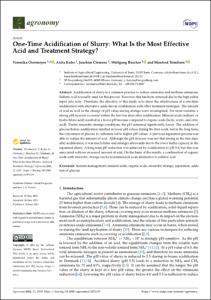One-Time Acidification of Slurry: What Is the Most Effective Acid and Treatment Strategy?

One-Time Acidification of Slurry: What Is the Most Effective Acid and Treatment Strategy?

| dc.contributor.author | Overmeyer, Veronika | |
| dc.contributor.author | Kube, Anita | |
| dc.contributor.author | Clemens, Joachim | |
| dc.contributor.author | Büscher, Wolfgang | |
| dc.contributor.author | Trimborn, Manfred | |
| dc.contributor.editor | Agronomy | |
| dc.date.accessioned | 2021-07-13T08:10:19Z | |
| dc.date.available | 2021-07-13T08:10:19Z | |
| dc.date.issued | 28.06.2021 | |
| dc.identifier.uri | https://hdl.handle.net/20.500.11811/9212 | |
| dc.description.abstract | Acidification of slurry is a common practice to reduce ammonia and methane emissions. Sulfuric acid is usually used for this process. However, this has been criticized due to the high sulfur input into soils. Therefore, the objective of this study is to show the effectiveness of a one-time acidification with alternative acids also in combination with other treatment strategies. The amount of acid as well as the change of pH value during storage were investigated. For most variants, a strong pH increase occurred within the first ten days after acidification. Mineral acids (sulfuric or hydrochloric acid) resulted in a lower pH increase compared to organic acids (lactic, acetic, and citric acid). Under anaerobic storage conditions, the pH remained significantly lower. The addition of glucose before acidification resulted in lower pH values during the first week, but in the long term, the conversion of glucose to carbonate led to higher pH values. A previous separation process was able to reduce the amount of acid. Although the pH increase was not that strong in the first days after acidification, it was much faster and stronger afterwards due to the lower buffer capacity in the separated slurry. A long-term pH reduction was achieved by acidification to pH 3.0, but this was associated with an increased amount of acid. On the basis of the results, a combination of organic acids with anaerobic storage can be recommended as an alternative to sulfuric acid. | en |
| dc.format.extent | 17 | |
| dc.language.iso | eng | |
| dc.relation.ispartofseries | 11 ; 1319 | |
| dc.rights | Namensnennung 4.0 International | |
| dc.rights.uri | http://creativecommons.org/licenses/by/4.0/ | |
| dc.subject | manure management | |
| dc.subject | mineral acids | |
| dc.subject | organic acids | |
| dc.subject | anaerobic storage | |
| dc.subject | separation | |
| dc.subject | addition of glucose | |
| dc.subject.ddc | 630 Landwirtschaft, Veterinärmedizin | |
| dc.title | One-Time Acidification of Slurry: What Is the Most Effective Acid and Treatment Strategy? | |
| dc.type | Wissenschaftlicher Artikel | |
| dc.publisher.name | MDPI | |
| dc.publisher.location | Basel, Schweiz | |
| dc.rights.accessRights | openAccess | |
| dcterms.bibliographicCitation.volume | 11 | |
| dcterms.bibliographicCitation.issue | 7 | |
| dc.relation.doi | https://doi.org/10.3390/agronomy11071319 | |
| dcterms.bibliographicCitation.journaltitle | Agronomy | |
| ulbbn.pubtype | Zweitveröffentlichung | |
| dc.version | publishedVersion | |
| ulbbn.sponsorship.oaUnifund | OA-Förderung Universität Bonn |
Dateien zu dieser Ressource
Das Dokument erscheint in:
-
Publikationen (5)





